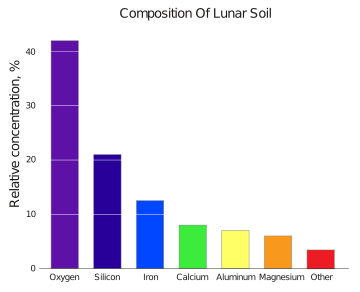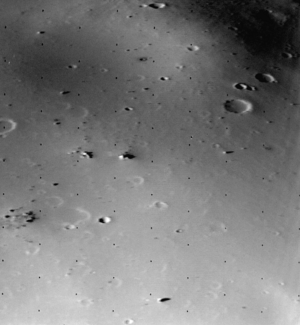Regolith facts for kids
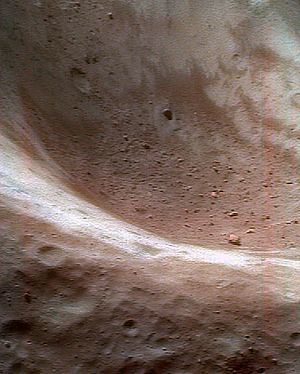
Regolith is a loose layer of mixed materials that covers solid rock. It includes dust, soil, broken rock, and other similar things. You can find regolith on Earth, the Moon, Mars, some asteroids, and other terrestrial planets and moons.
Contents
What Does "Regolith" Mean?
The word regolith comes from two Greek words. Rhegos (ῥῆγος) means "blanket," and lithos (λίθος) means "rock."
An American geologist named George Perkins Merrill first used this term in 1897. He described it as the entire layer of loose material covering the solid rock, no matter how it formed.
Regolith on Earth
On Earth, regolith is made of many different parts. It includes:
- soil
- alluvium (material moved by water, wind, ice, or gravity)
- "saprolith" (rock that has started to break down)
- volcanic ash and lava
- duricrust (hard layers formed when soils or rocks get cemented together)
- groundwater and water-deposited salts
- living things and organic parts from them
Regolith on Earth can be very thin or hundreds of meters thick. It can be very new, like fresh ash from a volcano. Or it can be very old, even hundreds of millions of years old.
Regolith on Earth forms from weathering (rocks breaking down) and biological processes (things living and dying). If it has a lot of living material, we usually call it soil. People also call Earth's regolith by names like dirt, dust, gravel, sand, and mud (when it's wet).
Regolith is very important for most life on Earth. Most plants cannot grow on solid rock. Animals also need loose material to dig or build homes.
Engineers also care about regolith when building roads or buildings. They need to know how strong or weak it is.
Regolith can also hold many valuable minerals. It is also a source of building materials like sand and gravel.
Regolith is also important for aquifers, which are underground water sources. Many aquifers are completely within regolith. The type of regolith can also change the quality of the water.
Regolith on the Moon

Regolith covers almost the entire lunar surface. Only very steep crater walls or lava channels show solid rock. This regolith formed over 4.6 billion years. It was created by impacts from large and small meteoroids. Tiny micrometeoroids and charged particles from the sun also break down surface rocks.
When micrometeoroids hit, they create a lot of heat. This heat melts or partly vaporizes dust particles. When these particles melt and refreeze, they stick together. They form glassy, sharp-edged pieces called agglutinates.
The regolith is usually about 4 to 5 meters thick in the darker, flat areas called mare. It is thicker, about 10 to 15 meters, in the older, brighter highland regions. Below this layer is a deeper zone of broken rock from larger impacts. This deeper layer is called "megaregolith."
The term lunar soil is often used for lunar regolith. But it usually means the finer parts, less than one centimeter in size. Some people say "soil" is not correct because Earth soil has organic content, which the Moon does not. However, lunar scientists often use the term anyway. "Lunar dust" means even finer material, less than 30 micrometers in size.
The lunar regolith changes over time due to "space weathering." This process makes the regolith darker. It also causes crater rays to fade away.
During the early Apollo missions, some scientists worried the lunar module might sink into a thick dust layer. But robotic Surveyer spacecraft showed the regolith was quite firm. Astronauts often had to use a hammer to push tools into it.
Regolith on Mars

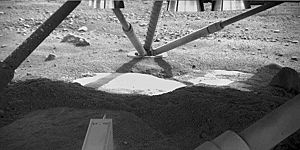
Mars has huge areas of sand and dust. Its surface is also covered with rocks and boulders. Sometimes, the dust is picked up in huge dust storms that cover the whole planet. Martian dust is very fine. Enough of it stays in the air to make the sky look reddish.
Scientists think the sand on Mars moves slowly because the atmosphere is very thin now. In the past, liquid water flowing in valleys might have shaped the Martian regolith. Researchers are still studying if water is shaping it today. They also look at whether frozen carbon dioxide plays a role. Scientists believe large amounts of water and carbon dioxide ice are frozen within the regolith in some parts of Mars.
Regolith on Asteroids
Asteroids also have regolith. It forms from meteoroid impacts. The best images of asteroid regolith come from the NEAR Shoemaker spacecraft on 433 Eros. The Japanese Hayabusa mission also took clear pictures of regolith on a very small asteroid. Scientists had thought gravity was too low on such a small asteroid for regolith to form. The asteroid 21 Lutetia has a regolith layer near its north pole. This layer flows in landslides.
Regolith on Titan
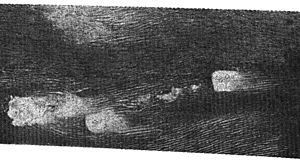
Saturn's largest moon, Titan, has large fields of dunes. We don't know exactly where the material for these dunes comes from. It could be small pieces of water ice worn down by flowing methane. Or it might be tiny bits of organic material that formed in Titan's atmosphere and fell to the surface.
Scientists are starting to call this loose icy material regolith. This is because it acts like regolith on other planets. Traditionally, the term "regolith" was only for loose layers made of rock or mineral grains. But Titan is so cold that ice behaves like rock. So, Titan has an "ice-regolith" that experiences erosion and wind or sedimentary processes.
The Huygens probe landed on Titan and studied the regolith. It found the surface was like a "clay-like material." Later analysis suggested the surface was more like "sand" made of ice grains. Pictures taken after the landing showed a flat plain covered in pebbles. These pebbles, likely made of water ice, are somewhat rounded. This might mean fluids have acted on them.
See also
 In Spanish: Regolito para niños
In Spanish: Regolito para niños



